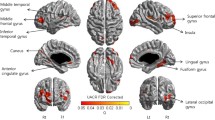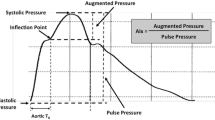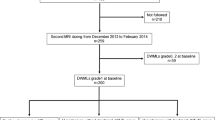Abstract
Hypertension is a major risk factor for stroke and dementia and is associated with white matter hyperintensities (WMH) and reduced brain volumes. We measured the increase in WMH volume, and rate of cerebral atrophy over two years, in hypertensive subjects participating in the Study on COgnition and Prognosis in the Elderly (SCOPE), receiving candesartan or placebo, and normotensive controls. We recruited 163 subjects who had MRI (FLAIR and volumetric T1) at 2 and 4 years after baseline assessment. From these two scans, volumetric change in WMH (n = 133) and brain atrophy rates (n = 95) were determined.
Total WMH fraction increased in both normotensive and treated hypertensive groups (p < 0.01) median change: 0.05% of brain volume [range: -0.45% to 1.51%]. Deep WMH increased in hypertensive (p = 0.001) but not the normotensive group. The number of subjects with an increase of total WMH in the 5th quintile differed between the treatment groups (chi square p = 0.006), being greatest in the placebo group (32%), then candesartan (20%) then normotensive (5%). Regression analysis found significant predictors of change in WMH to be blood pressure and initial deep WMH, but not treatment group. Increased atrophy rate was predicted by baseline systolic blood pressure (p = 0.02) but was not associated with measures of WMH. Similar to WMH, there was a trend with treatment, with atrophy in normotensive < Candesartan < Placebo (Spearman’s rho = 0.23, p = 0.026). Hypertension in older people is associated with increased rates of progressive whole brain atrophy and an increase in WMH. These changes are independent. Successful hypertension treatment was associated with reduced risk of WMH progression and possibly brain atrophy.
Similar content being viewed by others
References
Applegate WB, Pressel S, Wittes J, Luhr J, Shekelle RB, Camel GH, Greenlick MR, Hadley E, Moye L, Perry HM, Schron E, Wegener V (1994) Impact of the treatment of isolated systolic hypertension on behavioral variables. Results from the systolic hypertension in the elderly program. Arch Intern Med 154:2154–2160 http://dx.doi.org/ 10.1001/archinte.154.19.2154
Atwood LD, Wolf PA, Heard-Costa NL, Massaro JM, Beiser A, D’Agostino RB, DeCarli C (2004) Genetic variation in white matter hyperintensity volume in the Framingham study. Stroke 35:1609–1613 http://dx.doi.org/10.1161/ 01.STR.0000129643.77045.10
Beevers G, Lip GYH, O’Brien E (2001) ABC of hypertension: blood pressure measurement. BMJ 322:981–985 http:// dx.doi.org/10.1136/bmj.322.7292.981
Blood pressure lowering treatment trialists’ collaboration (2003) Effects of different blood-pressure-lowering regimens on major cardiovascular events: results of prospectively-designed overviews of randomised trials. Lancet 362:1527–1535 http://dx.doi.org/ 10.1016/S0140–0736(03)14739-3
Burton EJ, McKeith IG, Burn DJ, O’Brien JT (2005) Brain atrophy rates in Parkinson’s disease with and without dementia using serial MRI. Mov Disord Mov Disord 20(12):1571–1576 http://dx.doi.org/10.1002/mds.20652
de Leeuw FE, Barkhof F, Scheltens P (2004) Alzheimer’s disease - one clinical syndromes, two radiological expressions: a study on blood pressure. J Neurol Neurosurg Psychiatry 75:1270–1274 http://dx.doi.org/ 10.1136/jnnp.2003.030189
de Leeuw FE, de Groot JC, Oudkerk M, Witteman JCM, Hofman A, van Gijn J, Breteler MMB (2002) Hypertension and cerebral white matter lesions in a prospective cohort study. Brain 125:765–772 http://dx.doi.org/10.1093/brain/ awf077
DeCarli C, Miller BL, Swan GE, Reed T, Wolf PA, Garner J, Jack L, Carmelli D (1999) Predictors of brain morphology for the men of the NHLBI twin study. Stroke 30:529–536 http://www.sciencedirect.com/science/article/B6WVB- 45D8N9H-4WT/2/6b39c8086a3b2- ba84c2787c17c381c6f
den Heijer T, Skoog I, Oudkerk M, de Leeuw FE, de Groot JC, Hofman A, Breteler MMB (2003) Association between blood pressure levels over time and brain atrophy in the elderly. Neurobiol Aging 24:307–313 http:// dx.doi.org/10.1016/S0197- 4580(02)00088-X
Du A-T, Schuff N, Chao LL, Kornak J, Ezekiel F, Jagust WJ, Kramer JH, Reed BR, Miller BL, Norman D, Chui HC, Weiner MW (2005) White matter lesions are associated with cortical atrophy more than entorhinal and hippocampal atrophy. Neurobiol Aging 26:553–559 http://dx.doi.org/10.1016/ j.neurobiolaging.2004.05.002
Dufouil C, de Kersaint-Gilly A, Besancon V, Levy C, Auffray E, Brunnereau L, Alperovitch A, Tzourio C (2001) Longitudinal study of blood pressure and white matter hyperintensities: the EVA MRI cohort. Neurology 56:921–926
Enzinger C, Fazekas F, Matthews PM, Ropele S, Schmidt H, Smith S, Schmidt R (2005) Risk factors for progression of brain atrophy in aging: Six-year follow-up of normal subjects. Neurology 64:1704–1711
Fazekas F, Kleinert R, Offenbacher H, Schmidt R, Kleinert G, Payer F, Radner H, Lechner H (1993) Pathologic correlates of incidental MRI white matter signal hyperintensities. Neurology 43:1683–1689
Firbank MJ, Lloyd AJ, Ferrier N, O’Brien JT (2004) A volumetric study of MRI signal hyperintensities in latelife depression. Am J Geriatr Psychiatry 12:606–612 http://dx.doi.org/10.1176/ appi.ajgp.12.6.606
Firbank MJ, Minett T, O’Brien JT (2003) Changes in DWI and MRS associated with white matter hyperintensities in elderly subjects. Neurology 61:950–954
Forette F, Seux ML, Staessen JA, Thijs L, Babarskiene MR, Babeanu S, Bossini A, Fagard R, Gil-Extremera B, Laks T, Kobalava Z, Sarti C, Tuomilehto J, Vanhanen H, Webster J, Yodfat Y, Birkenhager WH, Systolic Hypertension in Europe I (2002) The prevention of dementia with antihypertensive treatment: new evidence from the Systolic Hypertension in Europe (Syst-Eur) study.[see comment][erratum appears in Arch Intern Med. 2003 Jan 27;163(2):241.]. Arch Intern Med 162:2046–2052 http://dx.doi.org/ 10.1001/archinte.162.18.2046
Fox NA, Freeborough PA (1997) Brain atrophy progression measured from registered serial MRI: validation and application to Alzheimer’s disease. J. Magn. Reson. Imaging 7:1069–1075
Fox NC, Cousens S, Scahill R, Harvey RJ, Rossor MN (2000) Using serial registered brain magnetic resonance imaging to measure disease progression in Alzheimer disease: Power calculations and estimates of sample size to detect treatment effects. Arch Neurol 57:339–344 http://dx.doi.org/10.1001/ archneur.57.3.339
Freeborough PA, Fox NC, Kitney RI (1997) Interactive algorithms for the segmentation and quantitation of 3-D MRI brain scans. Comput Methods Programs Biomed 53:15–25 http:// dx.doi.org/10.1016/S0169- 2607(97)01803-8
Hanon O, Forette F (2004) Prevention of dementia: lessons from SYST-EUR and PROGRESS. J Neurol Sci 226:71–74 http://dx.doi.org/10.1016/ j.jns.2004.09.015
Hansson L, Lithell H, Skoog I, Baro F, Banki CM, Breteler M, Carbonin PU, Castaigne A, Correia M, Degaute J-P, Elmfeldt D, Engedal K, Farsang C, Ferro J, Hachinski V, Hofman A, James OFW, Krisin E, Leeman M, de Leeuw PW, Leys D, Lobo A, Nordby G, Olofsson B, Opolski G, Prince M, Reischies FM, Rosenfeld JB, Ruilope L, Salerno J, Tilvis R, Trenkwalder P, Zanchetti A (1999) Study on COgnition and Prognosis in the Elderly (SCOPE). Blood Press 8:177–183 http://dx.doi.org/ 10.1080/080370599439715
Harrington F, Saxby BK, McKeith IG, Wesnes K, Ford GA (2000) Cognitive performance in hypertensive and normotensive older subjects. Hypertension 36:1079–1082
Knopman D, Boland LL, Mosley T, Howard G, Liao D, Szklo M, McGovern P, Folsom AR (2001) Cardiovascular risk factors and cognitive decline in middle-aged adults. Neurology 56:42–48
Korf ESC, White LR, Scheltens P, Launer LJ (2004) Midlife blood pressure and the risk of hippocampal atrophy: the Honolulu Asia Aging Study. Hypertension 44:29–34 http:// dx.doi.org/10.1161/ 01.HYP.0000132475.32317.bb
Liao D, Cooper L, Cai J, Toole J, Bryan N, Burke G, Shahar E, Nieto J, Mosley T, Heiss G (1997) The prevalence and severity of white matter lesions, their relationship with age, ethnicity, gender, and cardiovascular disease risk factors: the ARIC Study. Neuroepidemiology 16:149–162
Lithell H, Hansson L, Skoog I, Elmfeldt D, Hofman A, Olofsson B, Trenkwalder P, Zanchetti A (2003) The Study on Cognition and Prognosis in the Elderly (SCOPE): principal results of a randomized double-blind intervention trial. J Hypertens 21:875–886 http:// dx.doi.org/10.1097/00004872- 200305000-00011
Masana Y, Motozaki T (2003) Emergence and progress of white matter lesion in brain check-up. Acta Neurol. Scand. 107:187–194 http://dx.doi.org/ 10.1034/j.1600-0404.2003.02021.x
Petrovitch H, White LR, Izmirilian G, Ross GW, Havlik RJ, Markesbery W, Nelson J, Davis DG, Hardman J, Foley DJ, Launer LJ (2000) Midlife blood pressure and neuritic plaques, neurofibrillary tangles, and brain weight at death: the HAAS. Neurobiol Aging 21:57–62 http://dx.doi.org/10.1016/ S0197-4580(00)00106-8
Prince MJ, Bird AS, Blizard RA, Mann AH (1996) Is the cognitive function of older patients affected by antihypertensive treatment? Results from 54 months of the Medical Research Council’s trial of hypertension in older adults. BMJ 312:801–805
Prins ND, van Straaten ECW, van Dijk EJ, Simoni M, van Schijndel RA, Vrooman HA, Koudstaal PJ, Scheltens P, Breteler MMB, Barkhof F (2004) Measuring progression of cerebral white matter lesions on MRI: Visual rating and volumetrics. Neurology 62:1533–1539
Psaty BM, Furberg CD, Kuller LH, Cushman M, Savage P, Levine D, O’Leary DH, Bryan RN, Anderson M, Lumley T (2001) Association between blood pressure level and the risk of myocardial infarction, stroke, and total mortality - the cardiovascular health study. Arch Intern Med 161:1183-1192 http://dx.doi.org/10.1001/archinte. 161.9.1183
Ramsay LE, Williams B, Johnston GD, MacGregor GA, Poston L, Potter JF, Poulter NR, Russell G (1999) Guidelines for management of hypertension: report of the third working party of the British Hypertension Society. J Hum Hypertens 13:569–592 http:// dx.doi.org/10.1038/sj.jhh.1000917
Scahill RI, Frost C, Jenkins R, Whitwell JL, Rossor MN, Fox NC (2003) A longitudinal study of brain volume changes in normal aging using serial registered magnetic resonance imaging. Arch Neurol 60:989–994 http:// dx.doi.org/10.1001/archneur.60.7.989
Scheltens P, Barkhof F, Leys D, Pruvo JP, Nauta JJ, Vermersch P, Steinling M, Valk J (1993) A semiquantative rating scale for the assessment of signal hyperintensities on magnetic resonance imaging. J Neurol Sci 114:7–12 http:// dx.doi.org/10.1016/0022- 510X(93)90041-V
Schmidt R, Enzinger C, Ropele S, Schmidt H, Fazekas F (2003) Progression of cerebral white matter lesions: 6 year results of the Austrian stroke prevention study. Lancet 361:2046–2048 http://dx.doi.org/10.1016/S0140- 6736(03)13616-1
Schmidt R, Fazekas F, Kapeller P, Schmidt H, Hartung H-P (1999) MRI white matter hyperintensities: Three-year follow up of the Austrian stroke prevention study. Neurology 53:132–139
Skoog I, Lernfelt B, Landahl S, Palmertz B, Andreasson LA, Nilsson L, Persson G, Oden A, Svanborg A (1996) 15-year longitudinal study of blood pressure and dementia. Lancet 347:1141–1145 http://dx.doi.org/10.1016/S0140- 6736(96)90608-X
Sparks DL, Scheff SW, Liu H, Landers TM, Coyne CM, Hunsaker JC (1995) Increased incidence of neurofibrillary tangles (NFT) in non-demented individuals with hypertension. J Neurol Sci 131:162–169 http://dx.doi.org/10.1016/ 0022-510X(95)00105-B
Taylor WD, MacFall JR, Provenzale JM, Payne ME, McQuoid DR, Steffens DC, Krishnan KRR (2003) Serial MR imaging of volumes of hyperintense white matter lesions in elderly patients: Correlation with vascular risk factors. Am J Roentgenol 181:571–576
Tedesco MA, Ratti G, di Salvo G, Natale F (2002) Does the angiotensin II receptor antagonist losartan improve cognitive function? Drugs and Aging 19:723–732
Tzourio C, Anderson C, Chapman N, Woodward M, Neal B, MacMahon S, Chalmers J, Group PC (2003) Effects of blood pressure lowering with perindopril and indapamide therapy on dementia and cognitive decline in patients with cerebrovascular disease. Arch Intern Med 163:1069–1075 http:// dx.doi.org/10.1001/archinte.163.9.1069
Veldink JH, Scheltens P, Jonker C, Launer LJ (1998) Progression of cerebral white matter hyperintensities on MRI is related to diastolic blood pressure. Neurology 51:319–320
Walters RJL, Fox NC, Schott JM, Crum WR, Stevens JM, Rossor MN, Thomas DJ (2003) Transient ischaemic attacks are associated with increased rates of global cerebral atrophy. J. Neurol. Neurosurg. Psychiatry 74:213–216 http://dx.doi.org/10.1136/jnnp.74.2.213
Wiseman RM, Saxby BK, Burton EJ, Barber R, Ford GA, O’Brien JT (2004) Hippocampal atrophy, whole brain volume, and white matter lesions in older hypertensive subjects. Neurology 63:1892–1897
Yamano S, Sawai F, Yamamoto Y, Sawai N, Shigetoshi M, Akai M, Nomura K, Takaoka M, Fukui R, Dohi K (1999) Relationship between brain atrophy estimated by a longitudinal computed tomography study and blood pressure control in patients with essential hypertension. Jpn Circ J 63:79–84 http://dx.doi.org/10.1253/jcj.63.79
Author information
Authors and Affiliations
Corresponding author
Additional information
We thank the Astra Research Foundation UK and AstraZeneca International for financial support of these studies. The main SCOPE trial was supported by AstraZeneca International.
Rights and permissions
About this article
Cite this article
Firbank, M.J., Wiseman, R.M., Burton, E.J. et al. Brain atrophy and white matter hyperintensity change in older adults and relationship to blood pressure. J Neurol 254, 713–721 (2007). https://doi.org/10.1007/s00415-006-0238-4
Received:
Revised:
Accepted:
Published:
Issue Date:
DOI: https://doi.org/10.1007/s00415-006-0238-4




